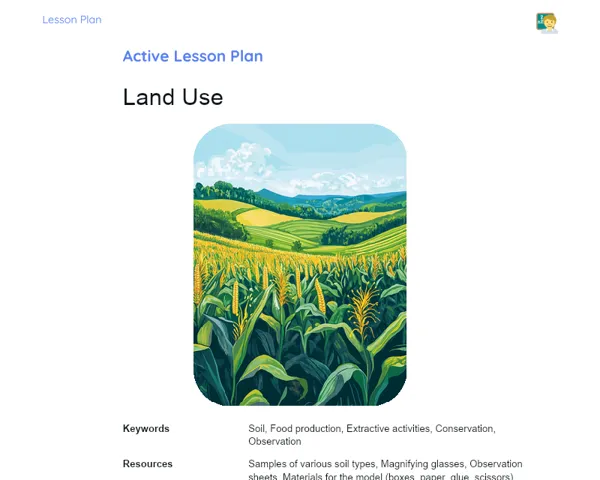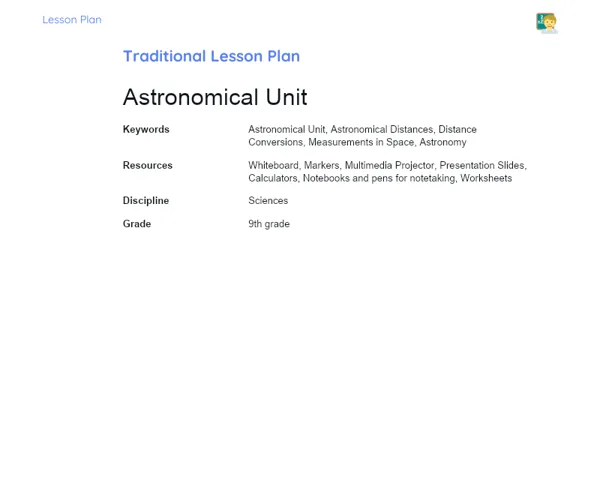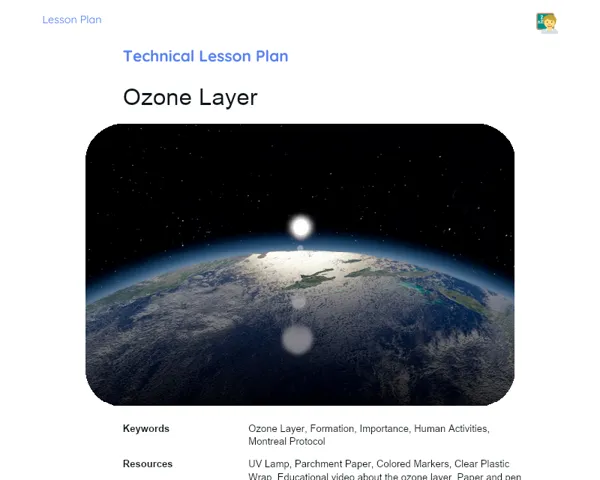Lesson Plan | Lesson Plan Tradisional | Renewable and Non-Renewable Energies
| Keywords | Renewable Energies, Non-Renewable Energies, Fossil Fuels, Environmental Impacts, Sustainability, Classification of Energy Sources, Energy Transition, Energy Sources, Solar Energy, Wind Energy, Hydroelectric, Biomass, Geothermal, Oil, Coal, Natural Gas, Nuclear Energy |
| Resources | Whiteboard and markers, Projector and laptop for slide presentations, Presentation slides on renewable and non-renewable energies, Illustrative images or graphs of various energy sources, Notebooks and pens for student notes, Printed copies of practical classification questions, Supplementary reading materials on renewable and non-renewable energies |
Objectives
Duration: 10 - 15 minutes
This lesson aims to give students a straightforward understanding of renewable and non-renewable energy sources. Such knowledge is crucial for accurately classifying different energy types and acknowledging the role of fossil fuels in our current energy landscape. By the end of this stage, students will be ready to explore the specifics and implications of each energy type.
Objectives Utama:
1. Define and differentiate between renewable and non-renewable energy sources.
2. Classify common examples of energy sources into renewable and non-renewable.
3. Understand the significance of fossil fuels as a non-renewable energy source.
Introduction
Duration: 10 - 15 minutes
This part of the lesson plan is designed to ensure that students grasp the basic concepts of renewable and non-renewable energy sources, which is fundamental for classifying various types of energy and understanding the importance of fossil fuels in today’s energy mix. By the end of this section, students will be equipped to discuss the complexities and implications associated with different energy types.
Did you know?
Did you know that the amount of solar energy our planet receives in just one hour could power the entire globe for a whole year? This highlights the vast potential of renewable energy, especially when you consider that fossil fuels take millions of years to form and can be used up in just a few decades.
Contextualization
To kick off the lesson on Renewable and Non-Renewable Energies, start by emphasizing the crucial role energy plays in our daily lives. Energy powers everything from our homes to industries, and the methods we use to harness it can significantly affect both our environment and society. Introduce the two primary categories of energy sources: renewable and non-renewable. Briefly explain that renewable sources are those that replenish naturally over a short period, while non-renewable sources are finite and can eventually run out.
Concepts
Duration: 40 - 50 minutes
This segment aims to provide a comprehensive understanding of renewable and non-renewable energy sources. By tackling definitions, examples, and environmental implications, students will be enabled to classify different energy types and comprehend the urgency of transitioning to renewable sources. This part of the lesson also encourages critical thinking through practical discussions.
Relevant Topics
1. Understanding Renewable Energies: Explain that renewable energies regenerate naturally over short timeframes. Examples include solar, wind, hydroelectric, biomass, and geothermal energy. Go into how each of these works and their environmental advantages.
2. Understanding Non-Renewable Energies: Clarify that non-renewable energies are those available in limited supplies and can be depleted. Include examples such as oil, coal, natural gas, and nuclear energy. Discuss how fossil fuels develop over millions of years and their slow regeneration process.
3. Environmental Effects: Explore the environmental repercussions of both energy types. Mention greenhouse gas emissions and environmental pollution linked to non-renewable sources, and highlight the lower pollution levels and sustainability of renewable sources.
4. The Role of Fossil Fuels: Discuss fossil fuels' significance in the current energy scene, emphasizing their high energy density and the challenges posed by depleting these resources, as well as the necessity of transitioning to renewable alternatives.
5. Classifying Energy Sources: Provide practical examples and encourage students to categorize them into renewable or non-renewable. Use images or charts to visualize the different energy types.
To Reinforce Learning
1. Classify these energy sources as renewable or non-renewable: solar energy, coal, natural gas, wind energy, and biomass.
2. Why are fossil fuels categorized as non-renewable energy sources?
3. List two negative environmental impacts of fossil fuel use and two advantages of renewable energy.
Feedback
Duration: 20 - 25 minutes
This stage provides an opportunity to review and embed the concepts learned, ensuring students can apply their knowledge about renewable and non-renewable energies. The feedback session also seeks to engage students actively through discussions and critical insights into the topic.
Diskusi Concepts
1. Classify the following energy sources as renewable or non-renewable: solar energy, coal, natural gas, wind energy, and biomass. 2. Solar Energy: This is a renewable energy source, as solar energy is inexhaustible and replenishes continually. 3. Coal: A non-renewable energy source formed over millions of years from organic material and has finite reserves. 4. Natural Gas: A non-renewable energy source, formed from ancient organic remains with limited availability. 5. Wind Energy: A renewable energy source harnessed from natural wind currents, which are continuously available. 6. Biomass: A renewable energy source derived from organic substances that can regenerate naturally within a short timeframe. 7. Explain why fossil fuels are considered a non-renewable energy source. 8. Fossil Fuels: They are deemed non-renewable because they originate from organic matter of plants and animals that lived millions of years ago. The process takes millions of years, and once they are used up, they cannot be restored within any reasonable timeframe. 9. Describe two negative environmental impacts of using fossil fuels and two benefits of using renewable energies. 10. Negative Environmental Impacts of Fossil Fuels: 11. Greenhouse Gas Emissions: Burning fossil fuels releases high levels of carbon dioxide (CO2), exacerbating global warming and climate change. 12. Environmental Pollution: Extraction and usage of fossil fuels contaminate air, water, and soil, affecting both human health and ecosystems. 13. Environmental Advantages of Renewable Energies: 14. Lower Pollutant Emissions: Renewable energy sources like solar and wind produce virtually no greenhouse gas emissions during generation. 15. Sustainability: Renewable energies, being inexhaustible in human terms, encourage the sustainable usage of natural resources and lessen reliance on fossil fuels.
Engaging Students
1. 📚 Engagement Questions for Students: 2. How might increased use of renewable energies improve our quality of life in the future? 3. What challenges do you foresee in shifting from fossil fuels to renewable energies? 4. Can you cite examples of how renewable energies are being utilized in your community or city? 5. What viable solutions can mitigate the adverse effects of fossil fuels while we move towards fully relying on renewable energies?
Conclusion
Duration: 10 - 15 minutes
The goal of this concluding segment is to reaffirm and consolidate the concepts discussed, ensuring students hold a comprehensive understanding of the topics. This conclusion serves to highlight the practical significance of the content and prepares students to employ this knowledge in their daily lives and future decision-making.
Summary
['Definition and differentiation between renewable and non-renewable energy sources.', 'Classification of common examples of energy sources into renewable and non-renewable.', 'Importance of fossil fuels as a non-renewable energy source.', 'Environmental impacts of renewable and non-renewable energy sources.', 'Benefits of renewable energies for the environment and sustainability.']
Connection
The lesson linked theoretical knowledge to practical applications by providing real-life examples of energy sources and their environmental and economic influences. Practical questions and classifications reinforced students’ comprehension of how these energy sources are utilized and their effects on our environment.
Theme Relevance
Understanding this topic is vital for our daily lives, as the manner in which we procure and consume energy directly impacts our quality of life, economic stability, and the environment. Grasping the distinctions between renewable and non-renewable sources and their impacts empowers students to make informed and responsible decisions regarding sustainability and the necessity for cleaner energy alternatives.



